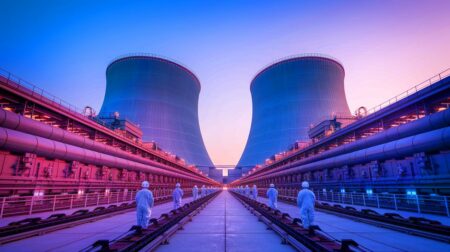| IN A NUTSHELL |
|
In a significant stride towards energy sustainability, the Independent Electricity System Operator (IESO) of Ontario has approved Bruce Power’s plan to refurbish Unit 5 of its nuclear facility. This ambitious project aims to extend the reactor’s life by up to 35 years, ensuring the continued provision of clean energy. As the world’s largest operating nuclear facility, Bruce Power’s efforts are not just about maintaining energy supply but also about securing a future where energy is sustainable, reliable, and affordable. This initiative highlights the importance of nuclear power in addressing both local and global energy needs.
Long-term Clean Energy
The refurbishment of Unit 5 involves replacing critical components like steam generators, pressure tubes, calandria tubes, and feeder tubes. These updates are crucial for extending the reactor’s lifespan by another 30 to 35 years. Unit 5 is the fourth among the six reactors at Bruce Power’s site slated for refurbishment, following the successful completion of Unit 6’s refurbishment last September. The ongoing work on Units 3 and 4, along with the planned refurbishments for Units 5, 7, and 8, underscores a long-term strategy through 2033.
Bruce Power’s initiative is not only about energy production but also about ensuring a stable supply of medical isotopes, which are vital in cancer treatment. As Eric Chassard, Bruce Power’s president and CEO, notes, “Ontario has become a world leader in nuclear power plant refurbishment.” This project exemplifies the province’s commitment to maintaining high standards of safety and quality in delivering complex major projects on time and within budget. The continued innovation in nuclear energy at Bruce Power demonstrates a significant contribution to both the economy and public health.
West Texas Measles Outbreak Nears 150 Cases, Raising Concerns
Economic and Social Impact
The ongoing refurbishment projects at Bruce Power are a testament to its role in bolstering the economy. Lesley Gallinger, IESO’s president, emphasizes that these projects ensure the long-term reliability and affordability of Ontario’s electricity system. They also significantly contribute to the economic and social well-being of communities throughout the province.
Since the initial agreement with IESO in 2005, which facilitated the return of Units 1 and 2, Bruce Power has maintained a commitment to local economic growth. The life-extension program, which has been supported by a revised agreement in 2015, involves substantial investments in Units 3 to 8. This support has resulted in generating approximately $10 billion annually, benefiting local businesses and enhancing Canada’s energy independence. Furthermore, Bruce Power’s projects offer long-term job opportunities, supporting 22,000 jobs in Ontario annually, thus reinforcing the province’s construction and trades workforce.
“China blows minds” – Supra-thermal ions in burning plasma cracked, rewriting physics as we know it
Environmental and Energy Security
The refurbishment of Bruce Power’s nuclear reactors is crucial in ensuring a sustainable energy future for Ontario. By upgrading the reactors, the province not only strengthens its energy security but also enhances its position as a global leader in clean energy. According to Lisa Thompson, a member of the provincial parliament, “This project will drive long-term prosperity and ensure Ontario continues to lead in both innovation and opportunity.”
The initiative also represents a significant step towards reducing carbon emissions by providing a reliable source of clean energy. Nuclear energy, with its low operational emissions, plays a vital role in the global fight against climate change. Bruce Power’s commitment to extending the life of its reactors reflects a broader strategy to integrate sustainable practices within the energy sector, ensuring that future generations inherit a cleaner, greener planet.
Challenges and Opportunities
While the refurbishment project presents numerous opportunities, it also comes with challenges that need addressing. The complexity of such large-scale projects requires meticulous planning and execution to avoid delays and budget overruns. However, Bruce Power’s track record of successful project delivery provides confidence in its ability to overcome these challenges.
Moreover, the project highlights the importance of international cooperation, as the nuclear industry often relies on a global supply chain for critical components. The emphasis on sourcing materials locally, as stated by Ontario’s Minister of Energy and Mines, Stephen Lecce, not only supports the local economy but also mitigates risks associated with global supply chain disruptions. The successful execution of this project can serve as a model for similar initiatives worldwide, demonstrating the potential of nuclear energy in achieving sustainable development goals.
As Bruce Power embarks on this ambitious journey of nuclear refurbishment, the implications extend beyond energy production. This project exemplifies a comprehensive approach to sustainability, economic growth, and public health. With the groundwork laid for a cleaner, more reliable energy future, the question remains: How will other regions learn from and adopt such initiatives to secure their energy and economic futures?
Did you like it? 4.7/5 (29)










How will this refurbishment affect local wildlife around the Bruce Power site?
Will there be any opportunities for local communities to get involved in the project? 🛠️
Great to see Canada investing in clean energy! 🌿 Keep it up!
Thirteen billion dollars!? Hope it’s worth every penny. 💸
Does this mean energy prices will go down for Ontario residents?
As a taxpayer, I hope this doesn’t mean more taxes! 😅
Interesting article! How many reactors does Bruce Power have in total?
What measures are in place to ensure safety during the refurbishment?
Bravo to Bruce Power for leading the way in sustainable energy! 👏
That’s the best news I’ve read in a long time.